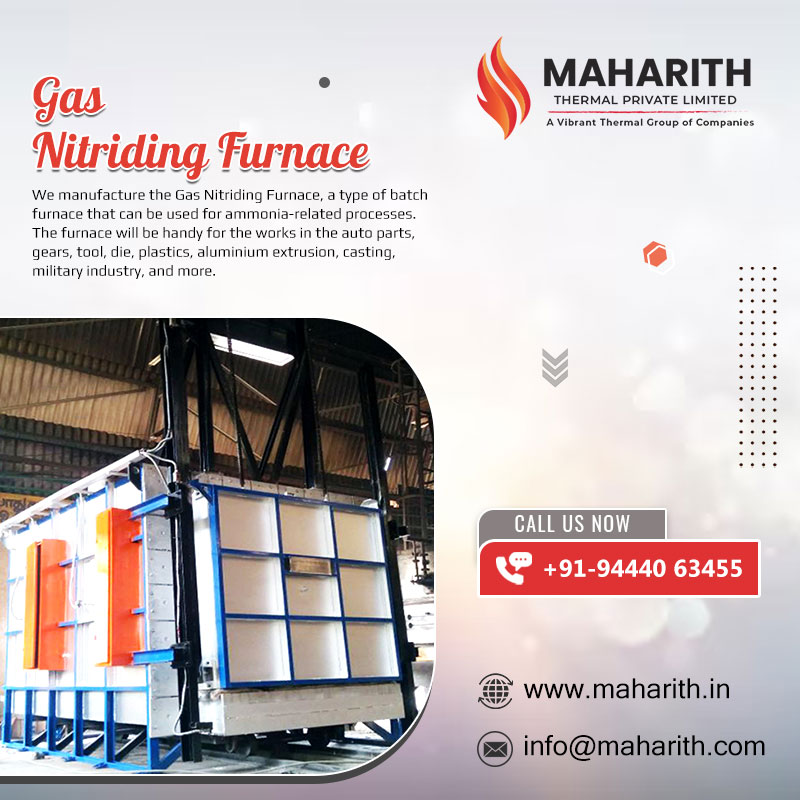What is a gas nitriding furnace, and what are its different types?

Strong 8k brings an ultra-HD IPTV experience to your living room and your pocket.
Gas Nitriding is a heat treatment procedure used to enhance resistance by assisting in the dissolution of nitrogen and hard nitride precipitates, completing the surface treatment process. During the nitriding process, a hard layer is produced on the material's surface by diffusing nitrogen into the steel. Gas Nitriding furnaces are furnaces used to carry out the nitriding process. These horizontal and vertical furnaces are used for surface hardening in the nitriding process at temperatures ranging from 480 to 580°C. It is a method used to treat alloy-rich steels. This treatment creates a hard coating on the steel surface that is resistant to wear and corrosion.
Types of Gas Nitriding Furnaces
Pit-type nitriding furnace
The pit-type gas nitriding furnace is mostly used for gas nitriding carbon steel components, quenching molds, and other heat treatments. It may also be utilized for gas nitrogen carbon co-diffusion (soft nitriding) treatment and is a popular heat treatment tool in industrial manufacturing.
Vertical Type Nitriding Furnace
Vertical nitriding furnaces typically feature a Kn-controlled structure. In addition, it has a touch screen and a color operator panel. The design occupies less space since it is vertical.
Horizontal Type Nitriding Furnace
The horizontal-type nitriding furnace has similar properties to the vertical-type nitriding furnace. Unlike the vertical form, it features a horizontal picture. The horizontal type gas nitriding furnace is a cycle-operated heat treatment electric furnace that is used mostly for gas nitriding steel components and auto parts.
The series of nitriding furnaces has a consistent furnace temperature, fast heating, good heat preservation, uniform nitrogen atmosphere, permeability, and when the furnace pressure is increased, there are no leaks. The equipment consists primarily of a complete fiber furnace, high-temperature resistant belt, muffle tank, hydraulic station, temperature control system, and so on.
Why Use Gas Nitriding Furnaces?
Nitriding furnaces, like ordinary nitriding furnaces, come in both horizontal and vertical configurations. Similarly, the nitriding process may be described as a surface hardening process carried out in gas nitriding furnaces employing various parameters within the temperature range of 490 to 580°C.
Gas nitriding is the favored method for alloy steels. At high temperatures, nitrogen atoms diffuse to the steel surface as interstitial atoms, generating an extremely hard coating that resists wear and corrosion. As a result of this procedure, the steel surface has two layers: a very hard white layer and a diffusion layer. Doing it at a low temperature significantly reduces distortion.
The nitriding depth ranges between 0.05 mm and 0.8 mm, depending on the process circumstances and material type. To achieve the highest efficiency following the nitriding process, hardened and tempered materials that have not been decarburized are recommended. A biphasic (Y/ε - nitride) nitriding layer forms when a suitable nitriding potential is applied at low temperatures.
Benefits of Gas Nitriding Furnaces
Nitriding is preferred for components that are subjected to strong loading because it gives a high surface hardness, promoting great resistance to wear, scuffing, galling, and seizure. Fatigue strength is primarily boosted by the formation of surface compressive stresses. Gas nitriding has a wide variety of applications due to the large range of achievable temperatures and case depths, which allow for the control of different characteristics of the treated components.
Application & Materials of Gas Nitriding Furnace
Gears, crankshafts, camshafts, cam followers, valve components, springs, extrusion screws, die-cast tooling, forging dies, aluminum-extrusion dies, injectors, and plastic molds are among the most common uses.
Nitriding is especially effective on steels having nitride-forming elements, including chromium, molybdenum, vanadium, and aluminum. The method is also suitable for tool steels, including hot-work, cold-work, and mold steels. Nitriding of spring steels is a low-temperature application that extends the fatigue life of vehicle springs. In general, all ferrous materials may be gas nitrided with up to 5% chromium. Plasma nitriding and gas nitriding may be used for stainless steel with greater alloying element levels. Gas nitriding of sintered steels of low density is not advised.
To achieve the best results, the material should be hardened and tempered before gas nitriding.
Conclusion
Gas nitriding is a thermochemical case hardening method that increases wear resistance, surface hardness, and fatigue life by dissolving nitrogen and hard nitride precipitations. If you are looking for gas-nitriding furnaces, look no further than Maharith Thermal Pvt Ltd.
Frequently Asked Questions
How does a gas-nitriding furnace work?
A gas nitriding furnace is a controlled-atmosphere heat treatment furnace that heats metal components in a particular gas environment. The furnace usually consists of a retort (or chamber) in which the pieces are put, a heating system to raise the temperature, and a system to manage the gas environment.
What gases are utilized during gas nitriding?
The main gases utilized in gas nitriding are ammonia (NH3) and nitrogen (N2). Other gases, such as hydrogen (H2) or methane (CH4), may be introduced to fine-tune the process.
How is the gas environment maintained in a gas nitriding furnace?
The gas environment is managed by adjusting the flow of gases into the furnace and utilizing a purging device to remove air from the chamber before heating. Gas analyzers and control systems monitor the gas composition and pressure within the furnace to keep the optimum environment.
Note: IndiBlogHub features both user-submitted and editorial content. We do not verify third-party contributions. Read our Disclaimer and Privacy Policyfor details.


